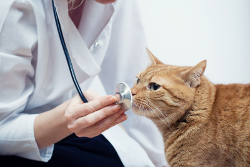Heartworms prompt fear in many pet owners, and for good reason. They are a very serious problem in dogs and are being recognized in cats. It used to be thought that only dogs got heartworms. While it is true that heartworms are more commonly seen in dogs, the parasite is increasingly being recognized to be an underlying factor in health problems for domestic cats.
Dirofilaria immititis are the blood-borne parasites that reside in the heart or the arteries of infected animals. A female heartworm is about 6 to 14 inches long. A male heartworm is approximately half the female’s size.
Causes of Heartworm Infection
Cats are naturally resistant hosts. Microfilareia is uncommon, being seen in in less than 20 percent of cases. The infection occurs when a mosquito carrying heartworm larvae bites a cat to feed on the cat’s blood. The heartworm larvae then migrate into their new host and mature as they travel through the cat’s subcutaneous tissue.
After about 3 to 4 months, the parasites settle into the blood vessels and arteries of the lungs. Here, they continue to mature into adults. The prepatent period is the average time it takes the parasite to enter the host and become mature worms producing offspring. In cats, the prepatent period is one month longer than dogs, averaging about eight months.
Clinical Signs of Heartworm Infection
The clinical signs can be non-specific. They tend to mimic many other diseases. Generic signs of illness are often exhibited, such as:
- Vomiting
- Lack of appetite
- Lethargy
- Weight loss
- Difficulty breathing
- Coughing
- Collapse
- Blindness
- Convulsions
When heartworms travel to the pulmonary arteries, the symptoms may be misdiagnosed as allergic bronchitis or asthma. These symptoms may actually be due to Heartworm Associated Respiratory Disease (HARD).
Cats often exhibit clinical signs related to the organs the heartworms are inhabiting.
How a Heartworm Infection is Diagnosed
Diagnosing a heartworm infection by clinical signs alone is not possible. It is more difficult to diagnose in cats than it is in dogs and is easier to overlook. For some diagnostic testing, a negative test result does not necessarily rule out an infection. The diagnostic plan for cats may include, but is not limited to:
A physical examination
Even in cats with heartworms, the results of a physical exam may be normal. Abnormal-sounding lungs are frequently found and may be present in cats that do not have any noticeable respiratory difficulties. This is often misdiagnosed if further diagnostic testing is not pursued.
X-rays
X-ray imaging is generally the best test for confirming a diagnosis of heartworm infection. It is also used to develop a prognosis (outlook for recovery).The enlargement of the pulmonary artery’s main trunk is not as common in cats as it is in dogs. In cats, the primary response to heartworm infection typically occurs in the lungs. Therefore, if the pulmonary arteries are enlarged with ill-defined margins, a diagnosis can be confirmed.
Echocardiograms
Echocardiography is ultrasonography. It is a noninvasive way to form visualizations of areas inside the body using sound. Echocardiograms are useful to identify heartworms within the heart, pulmonary arteries, and close areas of the right and left branches. However, using ultrasonography to visualize the extremities of the arteries where immature heartworms thrive is almost impossible. If heartworms are found using ultrasonography, a definite diagnosis of infection is given.
Complete Blood Count (CBC)
Cats with heartworm infection may demonstrate anemia, immature red blood cells, an increase in the number of white blood cells. Normal white blood cell counts does not necessarily rule out heartworm infection because they are usually not present in circulation consistently, occurring 4 to 7 months after initial infection and then intermittently.
Antigen testing
In an antigen test, the cat is tested for specific antigens that are found in adult female heartworms. Antigen tests are routinely used to detect heartworm infection in dogs. These tests are also approved for use in cats. In dogs, most tests will detect infections that consist of one or more mature female heartworms that are at least 7 or 8 months old. However, they do not detect infections that are less than 5 months in duration.
Unfortunately, some of these tests are not sensitive enough to detect many infections in cats. They tend to fail in detecting infections that consist of immature heartworms, male heartworms and some infections that consist of only 1 or 2 adult female worms.
Treatment for Heartworm Infections
Unfortunately, there is no anthelmintic treatment for heartworm infection in cats as there are for other internal parasites. Most cats that are exhibiting clinical signs of lung disease are monitored with chest X-rays every few months and given decreasing doses of prednisone.
Since cats are naturally resistant hosts, this allows time for a spontaneous cure to occur. In severe cases, heartworm extraction has been performed.
Prevention is Key
There are a number of monthly medications available from your veterinarian that prevent heartworm infection. It’s generally recommended for all cats to undergo serology testing prior to the administration of preventatives. These tests detect both antigens and antibodies to rule out possible heartworm infection.
It is also important to note that over time, your cat may develop a tolerance to the medication in their parasite prevention. If this occurs, your veterinarian will simply switch your cat to another product that has a different active ingredient. This switching of medication may continue for the duration of your cat’s life. Parasite prevention is crucial for optimal health and should begin as soon as possible.
Thanks for visiting www.catdandruffclinic.com, if you liked this article please like us using the side bar .


Comments are closed.